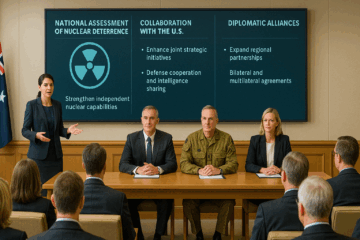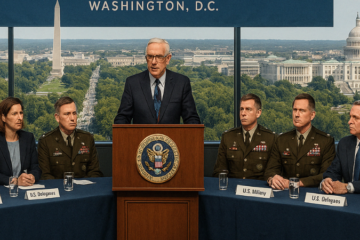Secretary of Defense Pete Hegseth’s recent “Message to the Force” is not merely a call to arms; it is a strategic blueprint to reshape American nuclear deterrence. It is a bold attempt to reverse the relative decline of American military might. His vision, born from a conviction that adversaries have grown emboldened by perceived American hesitancy, aims to forge a revitalized nuclear posture, one predicated on strength, resolve, and the restoration of a warrior ethos.
Secretary Hegseth, a veteran with combat experience in Iraq and Afghanistan, emerged from a military culture defined by counterinsurgency warfare, rapid technological adaptation, and constrained rules of engagement. His formative years were shaped by the leadership of prominent figures like General (Ret.) David Petraeus and General (Ret.) James Mattis, who emphasized adaptive leadership, decisive action, and strategic communication. The norms of that era often prioritized minimizing civilian casualties, leveraging asymmetric warfare, and coalition-based operations. Given this background, Hegseth’s emphasis on restoring a warrior ethos and projecting unyielding strength likely stems from his own military experiences and the influential leaders who shaped his perspective.
Hegseth’s message signals a deliberate shift away from the strategic ambiguity that may embolden adversaries. The emphasis on deterrence through strength suggests a belief that Russia’s nuclear brinkmanship, China’s rapid arsenal expansion, and North Korea’s unpredictability stem from a perception of American hesitancy. One might observe that the concept of strategic ambiguity, once hailed as a nuanced tool of deterrence, now appears as outdated as the punch-card computers that once calculated nuclear trajectories.
This shift reflects a growing concern about the credibility of extended deterrence and the need for more explicit signaling of American resolve. By modernizing the nuclear triad and reaffirming America’s willingness to use force, the Pentagon aims to reinstate fear as a core pillar of deterrence.
The emphasis on reviving the warrior ethos implies that nuclear deterrence must be as much about mindset as it is about capability. It is striking to note that the last time a Secretary of Defense emphasized a similar warrior ethos, the world was still reeling from the Cuban Missile Crisis, a stark reminder of the high stakes involved. The focus on a warfighting mentality suggests a move away from the bureaucratic approach that dominated nuclear policy in recent decades. It is a move toward a more operational and combat-focused posture.
The intent may be to move away from a risk-averse approach, ensuring that warfighters at all levels understand nuclear deterrence as an active, rather than passive, responsibility. This shift could result in more frequent readiness drills, a recalibration of nuclear employment thresholds, and strategic force posturing that prioritizes offensive capabilities over restraint.
China is projected to reach nuclear parity with the US by 2035, while Russia continues aggressive arsenal expansion and hybrid warfare tactics. Hegseth’s directive appears motivated by a desire to prevent a world where nuclear deterrence is no longer dictated by American supremacy. This shift away from the established norms of strategic restraint is a necessary adaptation to a multipolar world, or it could be a dangerous escalation that precipitates a new arms race.
There is an inherent tension between maintaining strategic dominance and fostering international stability. Modernization efforts—accelerated intercontinental ballistic missile production, hypersonic weapons, and a stronger nuclear-capable bomber fleet—align with an intent to sustain America’s dominant position before near-peer threats fully materialize.
The call to rebuild the military by rapidly fielding emerging technologies may suggest a strategic push toward AI tools that enable improved nuclear command and control, quantum-resistant encryption, and space-based early warning systems. The intent behind these investments appears twofold. First, there is a desire to ensure American nuclear forces cannot be neutralized by cyber, space, or electronic warfare. Second, there is a desire to establish deterrence dominance through superior technological integration before adversaries close the gap.
If this is a return to a bold, George S. Patton-style of leadership, where decisive action and unwavering resolve are paramount, it could also risk a dangerous overemphasis on military solutions at the expense of diplomacy. This approach raises crucial questions about the balance between technological innovation and strategic prudence.
Hegseth’s message reaffirms commitment to American allies, signaling that extended deterrence remains a central policy. The intent appears to be preempting concerns of American disengagement from NATO and Indo-Pacific security commitments while simultaneously warning adversaries, especially China, that American nuclear resolve is non-negotiable. Some may assume that a more aggressive posture inherently breeds instability, paradoxically, it could also create a more stable balance of power by clearly defining red lines and deterring potential aggression.
This strategy hinges on the assumption that adversaries will respond rationally to demonstrations of force. This could translate into increased nuclear deployments to allied territories; stronger trilateral deterrence initiatives between the US, UK, and Australia (AUKUS); and a renewed focus on NATO’s nuclear-sharing agreements to counter Russian regional threats.
Secretary Hegseth’s “Message to the Force” signals an intentional and urgent shift in US nuclear strategy—one motivated by a belief that deterrence is eroding and must be aggressively rebuilt. Whether through new weapons systems, a hardened warrior mindset, or the integration of cutting-edge technology, the modernization push under his tenure will likely define the next era of American nuclear policy.
Brandon Toliver, PhD, serves on the A4 staff of Headquarters Air Force. The views expressed are those of the author and do not reflect the official guidance or position of the United States government, the Department of Defense, the United States Air Force, or the United States Space Force.




